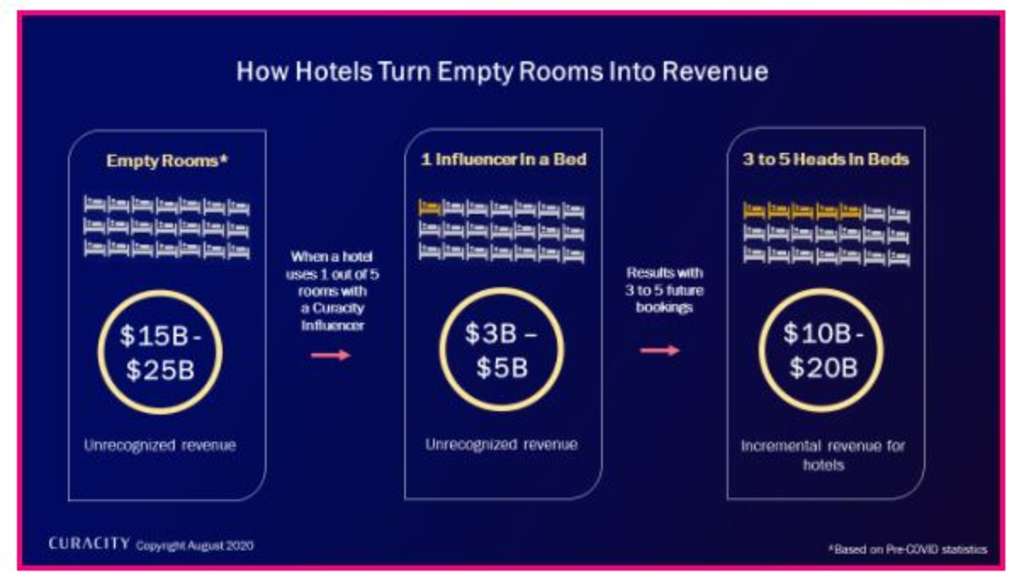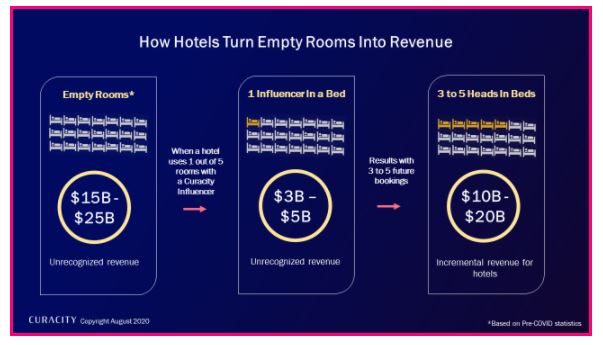A “New Normal” for Travel Influencers
Why Curacity’s Instagram Product Will be Critical for Hotels’ Comeback
Pre-COVID-19, the majority of hoteliers' sentiments could be captured in this one quote from an Atlantic Monthly article published in 2019:
"Everyone with a Facebook these days is an influencer. People say, I want to come to the Maldives for 10 days and will do two posts on Instagram to like 2,000 followers. It's people with 600 Facebook friends saying, 'Hi, I'm an influencer, I want to stay in your hotel for 7 days. These people are expecting five to seven nights on average, all-inclusive. Maldives is not a cheap destination." - Kate Jones, marketing and communications manager at the Dusit Thani, a five-star resort in the Maldives.
The rise of travel influencers created friction for hotel marketers.
This was particularly true in the early days of Instagram influencers. At that time, influencers were paid or provided with goods and services in exchange for an Instagram post. At first, these posts would be seen by about five percent of their followers. But, as Instagram's algorithm evolved, that number dropped, with only two percent of followers seeing that post organically. Soon, one-fifth of the world's population had registered with Instagram, and almost three percent of those claimed to be influencers (that would mean there were 60 million self-proclaimed Instagram influencers). It was nearly impossible to quantify who really had influence.How can that be true for the hotel eco-system? Luxury hotels that serve the top 10 to 20 percent of U.S., European and Asian households target 100 million global customers. So, are 60 million people really influencing that target audience of 100 million global customers?
It seemed like Instagram needed to separate the wheat from the chaff to make theirs an accessible marketing platform for luxury hotels and their distinct audience. And clearly the situation was ripe for disruption: Hotels were inundated by Instagram influencers—both wannabe's and quality influencers with meaningful influence. Instagram's scale was so fast and furious, that hotels were not prepared or provided with the analytical tools to identify true influence that would work for their unique property. Hotels were hard pressed to declutter the noise, and marketing departments were challenged to prove ROI efficacy.
By early 2019, Instagram allowed brands to pay to promote Influencer posts.
Enabling brands to "amplify" an influencer's post ensured that those posts could be seen by more than the organic reach of roughly two to four percent of their followers. Amplified posts became content marketing tools, enabling brands to reach the majority of the followers of the right influencers. Once amplified, an influencer's post to a following of one million people, once only seen 30,000 times (on average), could now be shown to one million people. Did hotels do this? And, if they did, did it help with measurement? Not really. There was still a missing link.Unlike its parent company Facebook, Instagram is unable to provide analytics to advertisers that prove their platform's online-to-offline sales and influence for hotels. This was brought to light by a 2019 report published in USA Today: "Native platforms like Instagram provide only certain metrics, which don't get at conversion rates." Travel and beauty influencer, Lindsay Silberman told USA Today, "What they don't show is how many people went into a store to make a purchase based on the influencer's recommendation, or how many people bought the product or booked the hotel at a later time." Silberman would take screenshots of her followers' direct messages to prove who to hotels that her followers actually booked hotel rooms based on her Instagram posts and recommendations.
Fast-forward to today's "new normal," where Instagram measurement for hotels is a reality. Curacity, an analytics and data measurement company, which works with Facebook's travel marketing team, has constructed the first data bridge to measure how Instagram posts lead to hotel bookings. Highgate Hotels is the flagship partner already working with Curacity on its Omni-Channel Revenue Attribution (ORA) program. It is the first hotel group to innovate their Instagram plan, and are actively measuring the ROI impact of Instagram influencer posts on revenue.
Highgate partnered with Curacity to prove a hotel's ROI from Instagram influencer posts.
Since Q4 of 2019, Curacity has vetted, placed and measured 1,000 influencer posts about participating Highgate properties. The findings are riveting:- One-third of Curacity influencers produced revenue
- Of those that produced revenue, Curacity's influencers turned one empty room into three to five downstream bookings
This translates into a new revenue stream of $10 billion to $20 billion for the luxury hotel industry.
How, you ask? Under non-COVID-19 circumstances, 20 percent of the industry's perishable inventory equates to $3 billion to $5 billion in unrecognized revenue. Hotels rarely operate at a 100 percent occupancy rate, and due to COVID-19 occupancy rates are at an all time low. If only one out of five empty rooms are filled with Curacity influencers—who are proven to drive three to five future bookings--at scale, that could generate $10 billion to $20 billion in new revenue for the luxury hotel industry. This means that hoteliers who use this "new normal" of empty rooms wisely, each Curacity influencer stay can reap three to five times its revenue in the future. (See graphic 1.)This kind of revenue scale would rival that of online travel agencies (OTA) or pay-per-click advertising (PPC) for some luxury hotels.
When COVID-19 changed everything, local travel became the only bright spot in today's travel ecosystem.
According to a poll of Curacity's influencers, 67 percent of reported that they would like to travel locally and safely amidst the pandemic. Curacity finds the best local Influencers who are willing to travel and can turn an empty room into future bookings and revenue.Curacity's award-winning data science team has found that 2,000 Curacity-vetted influencers yielded 35 percent positive revenue signals. Curacity has pioneered a proprietary, predictive model to allow hotels to turn empty rooms into revenue. Perhaps that is why it was named by Fast Company as one of the top 10 data science companies, and the only company named that serves the travel industry.
Curacity's Omni-Channel Revenue Attribution (ORA) for Instagram
Below is an overview on how the data analytics company measures the full financial impact of Instagram influence on direct hotel bookings.
- Curacity works with Instagram influencers that are looking to, travel locally, and who have the right audience. This is further defined as an Instagram following that has a high aptitude for travel (in the top 25 percentile of hotel bookers), plus a few other ways:
- The influencer's followers engage in luxury hotel content.
- The influencer's followers are geographically clustered around the influencer, indicating that they could easily travel to the same hotel.
- Curacity's platform authenticates influencers in real time.
- The influencer can book a room up to three months in advance. This is a win-win for the hotel and influencer:
- A win for influencers who need to plan their schedule.
- A win for hotels as they can outsource a myriad of influencer requests.
- Influencers pay a $50 processing fee (per night) split between the hotel and Curacity:
- Curacity remits a portion to that hotel to subsidize the cleaning fee
- The rest is spent by Curacity on:
- Acquiring the right influencers in the right location with the right followers
- Amplifying that influencer's post to reach their full audience, and beyond
- Curacity measures the influencer's impact on bookings.
- Curacity partner hotels grant the company access to its property management system data, all of which is encrypted and anonymized (and never used for anything outside of the platform).
- Curacity then connects those who engaged with that Instagram post, to those who then booked the hotel.
- With every influencer that is placed through its platform, Curacity's predictive model learns, evolves and becomes all the more effective at generating revenue for its hotel partners.
Curacity worked with Facebook on best practices for hotels and travel influencers. This download (https://www.curacity.com/fbbestpractices/) is filled with tactics on how to produce revenue-producing content on Instagram, along with stats and goals for a hotel's ability to maximize their social media and influencer programs:
Download now: https://www.curacity.com/fbbestpractices/.
- One third (1/3) of influencers drove hotel bookings. Of those, each influencer drove an average of five to six bookings delivering a 2:1 ROI on rooms in the program.
- Curacity has developed a proprietary predictive model that expects to weed out 90 percent of non-revenue-producing influencers.
- Hotels have a shot at delivering a 3:1 to 5:1 ROI at scale.
About Curacity
Curacity is a demand creation platform that helps travel brands measure revenue from upper-funnel marketing. By delivering premium content to opt-in subscribers of trusted media brands, Curacity enables hotels, resorts, and cruises to reach high-intent travelers during the inspiration phase, before they make purchase decisions. Its attribution technology closes the loop between marketing and bookings, identifying which media-exposed guests ultimately book a stay. Curacity empowers travel marketers to make smarter decisions with data by directly linking content to revenue. Named among Inc. 5000's top 20 travel and hospitality companies and Digiday's Best Content Marketing Platform of 2024, Curacity has its headquarters in New York with offices in Stamford, Conn., Toronto, and Buenos Aires. Visit www.curacity.com for more information.

